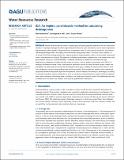| dc.contributor.author | Richardson, Alan | |
| dc.contributor.author | Hill, Christopher N. | |
| dc.contributor.author | Perron, J. Taylor | |
| dc.date.accessioned | 2015-07-28T14:51:42Z | |
| dc.date.available | 2015-07-28T14:51:42Z | |
| dc.date.issued | 2014-05 | |
| dc.date.submitted | 2013-06 | |
| dc.identifier.issn | 00431397 | |
| dc.identifier.uri | http://hdl.handle.net/1721.1/97904 | |
| dc.description.abstract | Models of landscape evolution or hydrological processes typically depend on the accurate determination of upslope drainage area from digital elevation data, but such calculations can be very computationally demanding when applied to high-resolution topographic data. To overcome this limitation, we propose calculating drainage area in an implicit, iterative manner using linear solvers. The basis of this method is a recasting of the flow routing problem as a sparse system of linear equations, which can be solved using established computational techniques. This approach is highly parallelizable, enabling data to be spread over multiple computer processors. Good scalability is exhibited, rendering it suitable for contemporary high-performance computing architectures with many processors, such as graphics processing units (GPUs). In addition, the iterative nature of the computational algorithms we use to solve the linear system creates the possibility of accelerating the solution by providing an initial guess, making the method well suited to iterative calculations such as numerical landscape evolution models. We compare this method with a previously proposed parallel drainage area algorithm and present several examples illustrating its advantages, including a continent-scale flow routing calculation at 3 arc sec resolution, improvements to models of fluvial sediment yield, and acceleration of drainage area calculations in a landscape evolution model. We additionally describe a modification that allows the method to be used for parallel basin delineation. | en_US |
| dc.description.sponsorship | National Science Foundation (U.S.). Geomorphology and Land-Use Dynamics Program (Award EAR-0951672) | en_US |
| dc.language.iso | en_US | |
| dc.publisher | American Geophysical Union (Wiley platform) | en_US |
| dc.relation.isversionof | http://dx.doi.org/10.1002/2013wr014326 | en_US |
| dc.rights | Article is made available in accordance with the publisher's policy and may be subject to US copyright law. Please refer to the publisher's site for terms of use. | en_US |
| dc.source | MIT web domain | en_US |
| dc.title | IDA: An implicit, parallelizable method for calculating drainage area | en_US |
| dc.type | Article | en_US |
| dc.identifier.citation | Richardson, Alan, Christopher N. Hill, and J. Taylor Perron. “IDA: An Implicit, Parallelizable Method for Calculating Drainage Area.” Water Resour. Res. 50, no. 5 (May 2014): 4110–4130. © 2014 American Geophysical Union | en_US |
| dc.contributor.department | Massachusetts Institute of Technology. Department of Earth, Atmospheric, and Planetary Sciences | en_US |
| dc.contributor.mitauthor | Richardson, Alan | en_US |
| dc.contributor.mitauthor | Hill, Christopher N. | en_US |
| dc.contributor.mitauthor | Perron, J. Taylor | en_US |
| dc.relation.journal | Water Resources Research | en_US |
| dc.eprint.version | Final published version | en_US |
| dc.type.uri | http://purl.org/eprint/type/JournalArticle | en_US |
| eprint.status | http://purl.org/eprint/status/PeerReviewed | en_US |
| dspace.orderedauthors | Richardson, Alan; Hill, Christopher N.; Perron, J. Taylor | en_US |
| dc.identifier.orcid | https://orcid.org/0000-0002-0404-8701 | |
| mit.license | PUBLISHER_POLICY | en_US |
| mit.metadata.status | Complete | |
